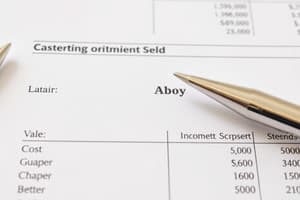Podcast
Questions and Answers
Which accounting method is recommended for high-priced goods in a merchandising operation?
Which accounting method is recommended for high-priced goods in a merchandising operation?
- Periodic Method
- Hybrid Method
- Perpetual Method (correct)
- Combination Method
The Periodic Method requires a physical count of inventory at the end of the accounting period.
The Periodic Method requires a physical count of inventory at the end of the accounting period.
True (A)
What is the Cost of Goods Sold?
What is the Cost of Goods Sold?
The carrying value of goods sold during a particular period.
The _________ Method is advisable for low-volume, low-priced goods.
The _________ Method is advisable for low-volume, low-priced goods.
Match the following terms with their definitions:
Match the following terms with their definitions:
What is the primary purpose of a trade discount?
What is the primary purpose of a trade discount?
A cash discount requires a journal entry separate from the transaction recording.
A cash discount requires a journal entry separate from the transaction recording.
What is the formula for calculating the invoice price after applying a trade discount?
What is the formula for calculating the invoice price after applying a trade discount?
A transportation term refers to the arrangement of how inventory will be transported and who will shoulder the _____ and inventory while in transit.
A transportation term refers to the arrangement of how inventory will be transported and who will shoulder the _____ and inventory while in transit.
Match the following types of discounts with their descriptions:
Match the following types of discounts with their descriptions:
If Pinnacle Technologies quotes a list price of P2,500 for a flash drive and offers a 20% trade discount, what would be the invoice price for one unit?
If Pinnacle Technologies quotes a list price of P2,500 for a flash drive and offers a 20% trade discount, what would be the invoice price for one unit?
No entry is required for trade discounts when recording a purchase.
No entry is required for trade discounts when recording a purchase.
What discount is given to encourage customers to pay promptly?
What discount is given to encourage customers to pay promptly?
What is the cash payment for an invoice of P150,000 with terms 2/10, n/30 if paid within the discount period?
What is the cash payment for an invoice of P150,000 with terms 2/10, n/30 if paid within the discount period?
The discount period for the terms 2/10, n/30 is 30 days.
The discount period for the terms 2/10, n/30 is 30 days.
What does 'n/30' indicate in credit terms?
What does 'n/30' indicate in credit terms?
For an invoice of P100,000 with terms 3/15, n/30, the cash payment on the 15th would be ______ if the discount is applied.
For an invoice of P100,000 with terms 3/15, n/30, the cash payment on the 15th would be ______ if the discount is applied.
Match the terms with their corresponding amounts or actions:
Match the terms with their corresponding amounts or actions:
What will a buyer pay if they delay payment on an invoice of P200,000 with terms 2/10, n/30?
What will a buyer pay if they delay payment on an invoice of P200,000 with terms 2/10, n/30?
A trade discount is typically applied after calculating any cash discounts.
A trade discount is typically applied after calculating any cash discounts.
In journal entries for a seller, what is typically recorded at the time of sale?
In journal entries for a seller, what is typically recorded at the time of sale?
Flashcards
Inventory Accounting Systems
Inventory Accounting Systems
Methods for tracking inventory in merchandising operations.
Perpetual System
Perpetual System
Inventory system continuously updating inventory account.
Periodic System
Periodic System
Inventory system updating inventory only at period-end.
Cost of Goods Sold
Cost of Goods Sold
Signup and view all the flashcards
Perpetual Method (COGS)
Perpetual Method (COGS)
Signup and view all the flashcards
Trade Discount
Trade Discount
Signup and view all the flashcards
Invoice Price
Invoice Price
Signup and view all the flashcards
Volume Discount
Volume Discount
Signup and view all the flashcards
Series Discount
Series Discount
Signup and view all the flashcards
Cash Discount
Cash Discount
Signup and view all the flashcards
Credit Terms
Credit Terms
Signup and view all the flashcards
List Price
List Price
Signup and view all the flashcards
Compute Invoice Price
Compute Invoice Price
Signup and view all the flashcards
2/10, n/30 credit terms
2/10, n/30 credit terms
Signup and view all the flashcards
Discount Period
Discount Period
Signup and view all the flashcards
Credit Term
Credit Term
Signup and view all the flashcards
Cash Discount
Cash Discount
Signup and view all the flashcards
Invoice
Invoice
Signup and view all the flashcards
Trade Discount
Trade Discount
Signup and view all the flashcards
Invoice Payment
Invoice Payment
Signup and view all the flashcards
Journal Entry (Accounting)
Journal Entry (Accounting)
Signup and view all the flashcards
Study Notes
Merchandising Operations
- Merchandising operations involve promoting goods and services for retail sale.
- Accounting cycle: Accountants use this process to prepare financial statements for a specific time period.
- Service operations: Involve selling expertise and time to consumers.
Source Documents
- Purchase Requisition: A written request for goods to be purchased from suppliers.
- Purchase Order: Authorization from the buyer for the seller to deliver merchandise.
- Sales Invoice: Contains buyer information, quantity, description, price, amount of sales, and payment terms.
- Bill of Lading: A document issued by the carrier specifying contractual conditions and terms of delivery.
- Receiving Report: Records information about goods from a vendor and details quantities and description of delivered goods.
- Statement of Account: A formal notice to a debtor detailing the account due.
- Deposit Slip: A form signifying a cash deposit.
- Check: A written order to the bank to pay a specified amount to a named person.
- Official Receipt: Evidence of cash received by the seller.
- Credit Memorandum: Used by the seller to notify the buyer that their account is decreasing.
- Debit Memorandum: Used by the buyer to notify the seller that their account is decreasing.
Terms of Transactions
- Credit Terms: Arrangement between buyer and seller outlining payment due dates, discounts, and interest/fees.
- Trade Discount: A reduction in the price of goods, given to encourage purchases.
- Cash Discount: An incentive for prompt payment received by customers.
- Transportation Terms: Arrangements for transporting inventory, outlining who bears the cost.
Inventory Accounting Systems
- Perpetual System: Continuously updated inventory records. Suitable for low-volume/high-priced goods.
- Periodic System: Inventory records are updated at the end of accounting periods. Suitable for large-volume/low-priced goods.
- Cost of Goods Sold (COGS): The carrying value of goods sold during a specific period.
- Perpetual Method: COGS records are maintained throughout the accounting cycle. Periodic Method: COGS is calculated at the end of accounting periods.
Journal Entries (Perpetual vs. Periodic Systems)
- Detailed journal entries for various transactions (purchases, sales, returns, discounts, etc.) are provided for both perpetual and periodic inventory systems in separate sections.
Example Transactions
- Real-world examples of journalizing transactions, including purchase, return, sales, payment, and discount scenarios.
Studying That Suits You
Use AI to generate personalized quizzes and flashcards to suit your learning preferences.





